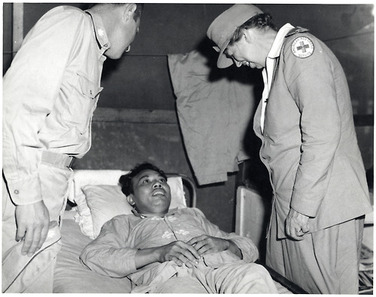|
J. William T. "Bill" Youngs, Eleanor Roosevelt:
A Personal and Public Life, Prologue |
"Eleanor Roosevelt in the South Pacific," Courtesy of the Franklin D. Roosevelt
Library and Museum website |
Prologue: The South Pacific, 1943 |
SummaryEleanor Roosevelt was not content simply to entertain White House guests during the Second World War. At the first opportunity, she made her way to the South Pacific to visit the troops and spread a message of goodwill. Her natural grace and charisma won her the love and support of nearly all of the many spectators who came to hear her speak and wounded soldiers in hospitals where she visited. This section of the book details her tour and and serves to illustrate and introduce her character.
|
Author reads from the Text
Guadalcanal was a large island, some two thousand square miles in area, where only a year earlier the Americans had launched their first major offensive against the Japanese. During six months of fighting in the jungles that covered the island the two sides suffered more than 25,000 casualties. The Japanese had withdrawn from the island, but they still attacked daily from the air.
After breakfast the First Lady began a grueling visit to the island hospitals. In the past few weeks she had talked to thousands of soldiers. And yet she retained an ability to treat each new patient as if he were the first wounded man she had seen. One reporter who had watched her meeting people wrote, "Every time she grasps a new hand her face lights up with a resolute effort to feel sincere, not to leave this a mere empty gesture. She tries to feel a genuine impulse for friendship toward the person she is greeting."
Eleanor Roosevelt had a feeling for the needs of the soldiers. "One boy told me his wife is expecting a baby in November," she later wrote, "and you could see longing in his eyes. Another one said, 'I am just going to get married and I wrote to my girl that I want her dressed in frills and chiffon when I get home.'" Most of the men she met had longings like these. At each bedside Mrs. Roosevelt paused and talked. A tough officer who had been assigned to accompany her against his will was soon won over by her manner. He reported: "When she chatted with the men, she said things mothers say, little things men never think of and couldn't put into words if they did. Her voice was like a mother's too."
After breakfast the First Lady began a grueling visit to the island hospitals. In the past few weeks she had talked to thousands of soldiers. And yet she retained an ability to treat each new patient as if he were the first wounded man she had seen. One reporter who had watched her meeting people wrote, "Every time she grasps a new hand her face lights up with a resolute effort to feel sincere, not to leave this a mere empty gesture. She tries to feel a genuine impulse for friendship toward the person she is greeting."
Eleanor Roosevelt had a feeling for the needs of the soldiers. "One boy told me his wife is expecting a baby in November," she later wrote, "and you could see longing in his eyes. Another one said, 'I am just going to get married and I wrote to my girl that I want her dressed in frills and chiffon when I get home.'" Most of the men she met had longings like these. At each bedside Mrs. Roosevelt paused and talked. A tough officer who had been assigned to accompany her against his will was soon won over by her manner. He reported: "When she chatted with the men, she said things mothers say, little things men never think of and couldn't put into words if they did. Her voice was like a mother's too."
Map of Eleanor Roosevelt's South Pacific Tour
The map below shows the course of Eleanor Roosevelts South Pacific Tour of 1943, during World War II. The pins are numbered according to the sequence of stops on the flight. Click on each for more information. In many cases the text boxes associated with the pin include text from the book Eleanor Roosevelt: a Personal and Public Life; in other cases they include generic information about the trip taken from the book. Finally some pins, indicating places not mentioned in the book, include photos from the tour or of the place.
• Click here to read the entire chapter on the South Pacific Tour.
• To read the entire book, Eleanor Roosevelt: a Personal and Public Life, borrow it from a friend, get it from the library, or order it from Amazon.
• This map is crowded with sites. To view it in detail use the navigation buttons to move in closer, or better still, click on the "View Eleanor Roosevelt's South Pacific Trip in a larger map" button beneath the map to the left -- that will take you to a map page that lists the stops one by one.
• The map was created on Google by Lee Nilsson.
• Click here to read the entire chapter on the South Pacific Tour.
• To read the entire book, Eleanor Roosevelt: a Personal and Public Life, borrow it from a friend, get it from the library, or order it from Amazon.
• This map is crowded with sites. To view it in detail use the navigation buttons to move in closer, or better still, click on the "View Eleanor Roosevelt's South Pacific Trip in a larger map" button beneath the map to the left -- that will take you to a map page that lists the stops one by one.
• The map was created on Google by Lee Nilsson.
View Eleanor Roosevelt's South Pacific Trip in a larger map

